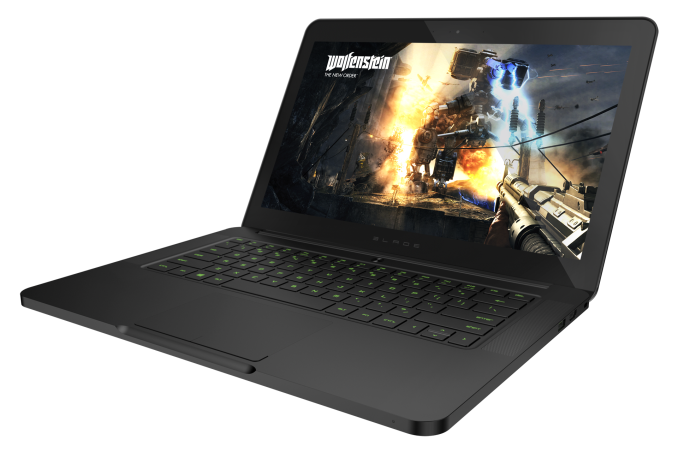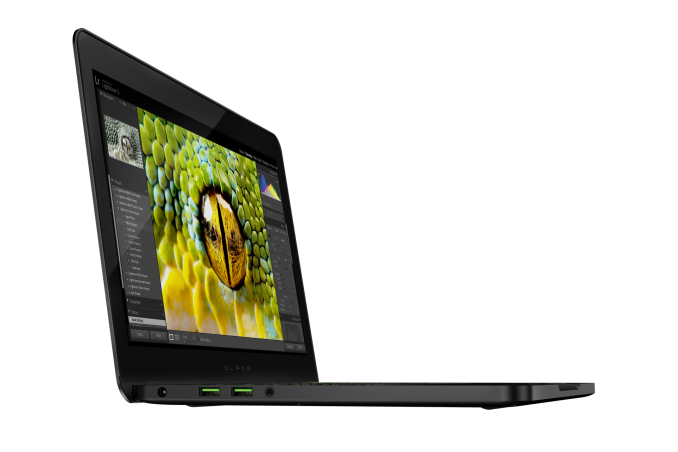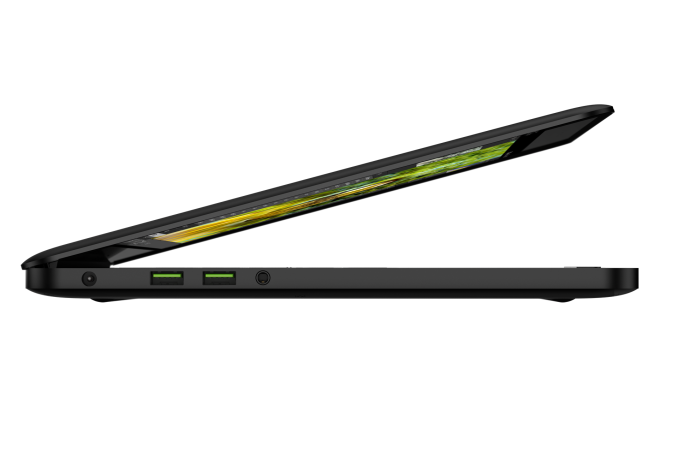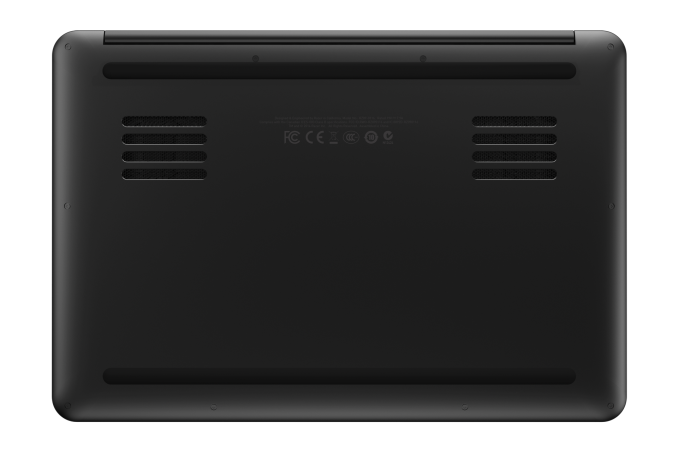Razer Announces the New Razer Blade: 14” QHD+ with GTX 870M
by Ian Cutress on March 12, 2014 2:54 PM EST
Gaming based laptops have boomed in recent months and quarters. There are plenty of companies getting their feet wet and some are trying to push the limits. QHD+ is starting to look like a new standard in the higher end laptops, as seen in the 13.3” Lenovo Yoga 2 Pro and the 15” Dell XPS 15 (read Jarred’s review of the XPS 15 here), and Razer are deciding to go with something similar for the 2014 Razer Blade refresh.
Aside from the touchscreen 14” QHD+ panel, which is an IGZO panel rather than the pentile screen seen on the Lenovo, the New Razer Blade 2014 edition is equipped with an Intel Core i7-4702HQ quad core processor, 8GB of DDR3L-1600 and the recently announced NVIDIA GTX 870M. That sounds like a beefy machine to begin with, and beats out the old Razer Blade that only had a 1600x900 panel and a GTX 765M.
This new device measures 345x235x17.9mm, which Razer likes to point out is smaller than a dime. The machine isn’t the lightest, weighing in at 4.47 lbs (2.03 kg), but we do get an Intel 7260 2x2 802.11ac WiFi module in there as well as a choice of SATA M.2 drives. Razer is accepting preorders based solely on the size of the M.2 drive: $2200 for a 128GB, $2400 for 256GB and $2700 for 512GB.
The keyboard is fully backlit in green, and the laptop uses a 70Wh battery with a 150W power adapter. This makes sense, given the CPU is a 37W part and the GPU is set to be rated around 100W. This would reinforce the image on Razer’s website of dual fans in the chassis. Connectivity comes via three USB 3.0 ports, a HDMI 1.4a port and headphone/microphone jacks.
| Razer Blade 14-Inch Specifications | |||||
|
2013 (Current) |
2014 (New) |
||||
| Processor |
Intel Core i7-4702HQ (4x2.2GHz + HTT, Turbo to 3.2GHz, 22nm, 6MB L3, 37W) |
Intel Core i7-4702HQ (4x2.2GHz + HTT, Turbo to 3.2GHz, 22nm, 6MB L3, 37W) |
|||
| Chipset | Intel HM87 | Intel HM87 | |||
| Memory | 8GB DDR3L-1600 | 8GB DDR3L-1600 | |||
| Graphics |
NVIDIA GeForce GTX 765M 2GB GDDR5 768 CUDA cores, 797MHz/863MHz core 4GHz memory 128-bit memory bus Intel HD 4600 Graphics (20 EUs, up to 1.15GHz) |
NVIDIA GeForce GTX 870M 3GB GDDR5 1344 CUDA cores, 941 MHz core 5 GHz memory clocks 192-bit memory bus Intel HD 4600 Graphics (20 EUs, up to 1.15GHz) |
|||
| Display |
14" LED Matte 16:9 900p AU Optronics AUO103E |
14" IGZO 16:9 3200x1800 Multitouch with LED Backlight |
|||
| Hard Drive(s) |
Samsung PM841 256GB mSATA 6Gbps SSD |
128GB / 256GB / 512 GB SATA M.2 |
|||
| Optical Drive | - | - | |||
| Networking |
Killer Wireless-N 1202 Dual Band 2x2 802.11a/b/g/n Bluetooth 4.0 |
Intel Wireless-AC 7260HMW Dual Band 2x2 802.11a/b/g/n/ac Bluetooth 4.0 |
|||
| Audio |
Realtek ALC269 HD audio Stereo speakers Combination mic/headphone jack |
? | |||
| Battery | 70Wh | 70Wh | |||
| Front Side | - | - | |||
| Right Side |
USB 3.0 HDMI 1.4a Kensington lock |
USB 3.0 HDMI 1.4a Kensington Lock |
|||
| Left Side |
AC adapter 2x USB 3.0 Combination mic/headphone jack |
AC adapter 2x USB 3.0 Combination mic/headphone jack |
|||
| Back Side | - | - | |||
| Operating System | Windows 8 64-bit | Windows 8.1 64-bit | |||
| Dimensions |
13.6" x 9.3" x 0.66" 345mm x 235mm x 16.8mm |
13.6" x 9.3 " x 0.70" 345mm x 235mm x 17.9mm |
|||
| Weight |
4.1 lbs 1.88 kg |
4.47 lbs 2.03 kg |
|||
| Extras |
Webcam USB 3.0 Killer Networks wireless networking Backlit anti-ghosting keyboard |
2.0 MP Webcam USB 3.0 Intel 2x2 802.11ac Backlit anti-ghosting keyboard |
|||
| Warranty | 1-year limited | ? | |||
| Pricing | $1,799 | Starting at $2200 for 128GB | |||
Powering 5.76 million pixels in QHD+ rather than 2.07 million of 1080p means an almost three-fold increase, and 4x over the older Razer Blade at 900p. That begs the question as to what frame rates we might see at 3200x1800 in this new device. I doubt that BF4 will be running at some high quality settings at 3200x1800, but I like the fact that the industry is headed to higher density panels in a smaller chassis.
Because I have been lax at being a proper gamer these past few years, my eyes would really open to a version of this without the discrete GPU – give me a high density, top quality panel with a lot of battery life and my usual OS, and all is good. However for running around to a LAN, it would either be an SFF machine or something like this that would fit right in.
Razer is taking pre-orders for shipping next month. In an interview with TechCrunch, Razer CEO Min-Liang Tan explained how the company has listened to their customers, and aim to help alleviate the previous issues regarding keeping up with demand. Markets like Russia and Taiwan will follow after North America.




















56 Comments
View All Comments
theqat - Wednesday, March 12, 2014 - link
You're actually not, "lap"tops have carried health warnings related to that type of use for many years for good reasons. You also risk blocking vents on virtually any soft surface no matter how high-performance the computer is (even netbooks).Lapdesks are the superior solution.
jasonelmore - Wednesday, March 12, 2014 - link
I wonder what Bus the M.2 SSD's will be on? Hopefully not Pci 1.0 lol.Penti - Wednesday, March 12, 2014 - link
SATA, just look at their specs (website). So SATA III/6Gbps.Connoisseur - Thursday, March 13, 2014 - link
Isn't it the SATA Express interface? Should be a lot faster than SATA III.Penti - Thursday, March 13, 2014 - link
M.2 can support or use either PCI-e or SATA. This uses SATA III/6. Kinda like having a mSATA (Mini PCI-e) slot that can support WLAN-cards and SATA mSATA-SSDs. M.2 can also be used for non SSD-devices.programcsharp - Wednesday, March 12, 2014 - link
Needs Thunderbolt and at least 16 GB RAM. With that, I'd spring for the $3k version in a heartbeat.Without, it's hard to justify buying a brand new laptop that will be obsolete next year.
dishayu - Thursday, March 13, 2014 - link
I can (only partly) agree with more RAM but lack of Thunderbold will not make the laptop obsolete. The only reason thunderbold has even survived this long is Intel's backing. It'll see the same fate as firewire.jasonelmore - Thursday, March 13, 2014 - link
nah the only reason its survived this long is because of Apple. However, its still the only way to hook a device straight up to the PCI Bus, and it's damn fast.CalaverasGrande - Wednesday, March 19, 2014 - link
firewire did not die. Liek many superior technologies it failed to garner much support with consumers, but was embraced by pros. We use firewire daily in broadcast, and only gave up Beta a few years back. I just ewasted our last beta decks in 2012.Thunderbolt is Intel IP, so it won't have the $1 a port licensing barrier that Apple imposed on firewire.
Thunderbolt will probably have better traction with consumers since most of them aren't buying midtower machines anymore. It's a natural fit for high speed connectivity and laptops, NUCs and NASes. Though most companies are making DAS or NAS products, I've not seen any that bridge the two connection types in one box.
Connoisseur - Thursday, March 13, 2014 - link
I would love to hear about a gaming use-case where you need more than 8GB of RAM. 16GB isn't necessary unless you're running a bunch of virtual machines, something which the blade isn't designed for.I hardly think this will become obsolete even in the next couple of years...